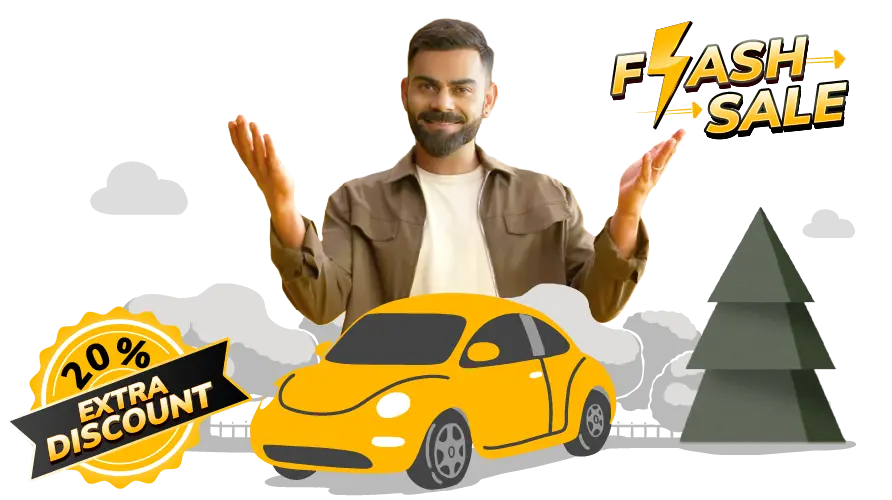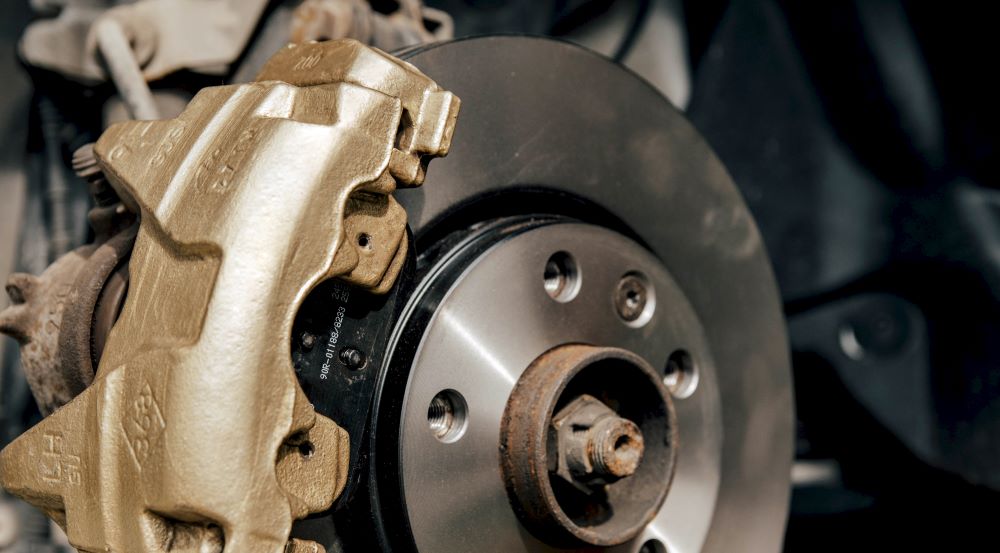9000+ Cashless Garages
96% Claims Settled (FY 24-25)

9000+ Cashless Garages
96% Claims Settled (FY 24-25)



Brakes are the most crucial safety feature of any vehicle. The purpose of brakes or braking systems is to reliably and safely decelerate a vehicle regardless of its speed. Moreover, brakes keep an automobile stationary when there is no driver or if it is standing on a slope.
Learning about what is a brake or the different types of brakes is crucial when caring for or repairing brakes.
A brake is a mechanical device that ceases motion by absorbing energy from a moving mechanism. Whereas, a braking system in an automobile is a configuration of several components and linkages that uses the kinetic energy of a moving vehicle and converts it to thermal energy via friction. It halts or decelerates a vehicle.
Several components in a braking system convert moving energy into heat using friction. Below is the application of braking system on automobiles on a step-by-step basis:
Step 1: To stop the motion of a vehicle, the driver presses brake shoes or pads against the rotating parts of a vehicle (it might be a drum or disc).
Step 2: Soon, kinetic energy or the vehicle’s momentum converts into heat energy due to the friction produced as the surfaces rub against each other. It causes a vehicle to slow down or halt.
Step 3: As the automobile ceases to move, it stays in its place by the action of static friction. This friction between the vehicle tyres and the surface and between brake surfaces resists further movement.
Step 4: To again bring the vehicle into motion, the driver's release brakes. It causes heat energy to convert to kinetic energy through the drive and transmission train, causing the vehicle to move.
The following are different types of brakes:
Disc brakes come with brake rotors that directly connect to the vehicle’s wheel. A disc brake uses callipers to pressure pairs of pads against a rotor or disc to create friction.
Function
Hydraulic pressure from the master cylinder allows a brake calliper to pressure brake pads on both sides of a rotor. A brake calliper is the one that holds the brake pads to the outer surface of the rotor. The collision between the brake pads and the rotor allows your vehicle to halt or slow down.
Advantages
Below are the benefits of a disc rotor that uses an external contracting braking mechanism:
Allows better braking control
Allows you to stop your vehicle accurately in a variety of road conditions
Generates less heat
Transmits high torque in a small volume
It is another type of brake with a brake drum that connects to the inner surface of a wheel.
Function
As a brake pedal contracts, the hydraulic pressure forces both brake shoes against the brake drum. This action develops friction and allows your vehicle to halt or slow down.
Advantages
The following are the benefits of drum brakes that utilise an internal expanding braking system:
You may also like to read about:
Almost all modern vehicles have emergency brakes. Also known as parking brakes, it is a secondary braking mechanism that functions independently in service brakes. These brakes allow a moving element to remain stationary when they are parked. Besides, emergency brakes are functional during emergencies if the stationary brakes fail to act.
There are several types of emergency brakes, which includes a stick lever between the driver and passenger, a handle or push-button near the steering column, a third pedal etc.
Function
All emergency brakes have wires that mechanically apply pressure to vehicle wheels. The emergency brake bypasses your vehicle's hydraulic brake system to lock its wheels in place. It will stop the vehicle from moving further.
Advantages
The advantages of emergency brakes are as follows:
Lowers risk of collision
Enhances the stopping power of a vehicle
Besides emergency brakes, Anti-lock braking systems, or ABS, are found on all modern vehicles. When a driver applies an emergency brake suddenly, anti-lock brakes prevent vehicle wheels from locking up.
It prevents the vehicle tyres from skidding on the road. This unique characteristic is useful when vehicles drive in slippery or wet road conditions.
Function
If your vehicle has ABS, as you apply brakes, your vehicle’s speed sensors identify the decreasing rotation of wheels. So, when the spin is about to stop, this mechanism will send a signal to the electric control unit or ECU to stop the vehicle from moving further.
Advantages
Advantages of Anti-lock brakes include:
Reduces wearing of brake pads and discs
Lowers the risk of vehicle wheels locking up
Prevents vehicle skidding, especially in slippery conditions
The following are the different types of braking systems:
Depending on Power Source
The power source that a driver applies on a brake pedal to control the final brake disc or drum to decelerate or halt a vehicle in a braking system is of six types. These include:
It is one of the oldest mechanisms used in previous motor models. A mechanical braking system is an emergency or hand brake.
Function
In this system, the braking force applied to the brake pedal is transmitted via various mechanical linkages to the final brake disc or drum to stop or rotor any vehicle. It includes- fulcrums, springs, cylindrical rods, etc.
Advantages
The following are the advantages of a mechanical braking system:
Great use for parking and emergency brakes
Simple design and easy to maintain
Cost-effective in comparison to a hydraulic brake system
One of the most crucial braking mechanisms in modern vehicles, the hydraulic braking system is a type where brake fluid, friction and cylinders are applicable.
Function
Diethylene glycol, or glycol, ether forces brake pads to cease the wheels from moving by forcing pressure inside the mechanism. The brake force that a driver applies on the brake pedal first converts to hydraulic pressure from the master cylinder. Then, it transfers to the brake disc or drum rotor through brake lines.
Advantages
The following are the advantages of a hydraulic braking system:
Less chance of brake failure due to the direct connection between the brake disc or drum and the actuator
Ensures equal braking effort on all wheels of a vehicle
Higher brake force generation and high effectiveness
Relative brake effort is less to deliver similar output
Each brake receives complete pedal effort
Suitable for vehicles with independent suspension
Pneumatic or air brakes use compressed air that a compressor generates and stores in a reservoir. Pneumatic or air brakes are suitable for heavy vehicles like trucks and buses. It is because hydraulic brakes cannot transmit high brake force through greater distances.
Function
When a driver actuates the pedal or lever, compressed air flows through a valve to a piston that engages the brake. Then, a spring releases the brake when the pressure is released.
Advantages
Below are the advantages of a pneumatic or air braking system:
Suitable for heavy vehicles and high-end vehicles due to high effectiveness
The risk of brake failure is low as they have a reserve air tank
Cost-effective, reliable mechanism and less maintenance
Low torque requirement
Easy to control even with a single pedal that works on the entire pneumatic brake equipment
Servo or vacuum braking system is a conventional configuration reliable in old trains and rail wagons. The brake lines, valves, exhauster, main cylinder and disc rotor/drum are the main components that assemble to make a vacuum braking system.
Function
In this system, the vacuum inside brake lines allow brake pads to move. This function finally stops or decelerates a vehicle. The pressure that a driver applies on the pedal increases.
Advantages
Below are the advantages of a vacuum or servo braking system:
Cost-effective
Simple design and high safety levels
Easy to control as it allows the automatic process to apply brakes through the entire vehicle's length by applying a force.
Highly effective as it doesn’t require any additional equipment.
Electromagnetic braking systems are there in several hybrid and modern vehicles. This configuration uses the electromagnetism principle to get frictionless braking. It ensures increased service life and brake reliability.
Function
When electricity is applied to an electromagnetic coil, the magnetic flux in this braking system pushes the armature close to the brake surface. Then, it forces the outer and inner friction disks together. The hub sits on the shaft that spins.
As current flows in a direction opposite to the direction of rotation of the wheel, it creates a force opposite to the wheel rotation and slows the wheel of a vehicle.
Advantages
Below are the advantages of an electromagnetic braking system:
It is a quick and cost-effective braking system
No additional maintenance cost is involved in replacing brake shoes
Improves the system's functioning, such as enhancing higher speeds, heavy loads, etc.
Generates low amount of heat, reducing chances of brake failure
Enhances lifespan and reliability of brakes
Low running costs and less or no wear and tear due to no friction
An electric braking system is prevalent in electric vehicles where the brake is applied by using electrical motors. It is a primary power source in electric vehicles. The three types of electric braking systems are as follows:
Plugging Brakes: Plugging brakes are a simple braking mechanism that runs efficiently when a driver presses a brake pedal in an electric vehicle. It consists of plugging-braking.
Function: In this system, the polarity of the motors alters, which changes the motor’s direction and applies the brake.
Regenerative Braking: It is a type of electrical braking where during the time of applying brakes, a motor that is a primary power source of a vehicle becomes a generator.
Function: When a driver applies brakes, the power supply stops reaching the motor. It causes mechanical energy from the wheels to convert to the rotating force for the motor. It, in turn, converts this mechanical energy into electric energy. This energy is reserved in a battery. This form of braking saves energy and is widely applicable in electric vehicles today.
Dynamic or Rheostat Braking: In this braking mechanism, the resistance that the rheostat provides initiates the brake.
Function: Here, a rheostat attaches to the circuit. This circuit ensures motor resistance. So, the motor is responsible for deceleration or stopping vehicle movement.
Advantages
The following are the advantages of an electric braking mechanism:
Saves energy
Highly efficient and requires less maintenance cost
No frequent replacement of braking system components
Cost-effective as it functions in an effective manner
Enhances speed capacity in the braking mechanism
Safer mechanism ensuring no shocks
Depending on Application
Depending on the mechanism of application of brakes, there are two types of braking systems such as:
This mechanism applies to cars and bikes that allow the foot or hand to operate the brakes.
Function
In this mechanism, when the driver applies brakes on a pedal that sits inside the cockpit, it increases the pedal force. Then, it flows to the disc or braking drum by mechanical connections or hydraulic pressure. This application initiates brake.
Advantages
Below are the advantages of a foot or service braking system:
Controls the weight transfer of a vehicle
Saves a lot of time during emergency braking
Cost-effective
Parking or hand brakes are also known as an emergency braking mechanism, as it allows the vehicle to remain stationary while parking. It is applicable when the hydraulic brakes fail to function.
The components of this braking system include hand brakes. It has a manually operated brake lever. This lever connects to the disc rotor or the brake drum through a metallic wire.
Function
As a driver pulls the hand brake lever the metallic rod functions. This operates the disc rotor or the brake drum causing the vehicle to halt. Parking brakes function only on the rear wheels of an automobile.
Advantages
The following are the advantages of parking or hand-braking mechanism:
Stable parking on a slope or a flat surface area
Reduces traction during the braking
It prevents the wheels from locking with each other
Depending on Force Distribution Mechanism
On the basis of the force distribution mechanism, there are again two types of braking systems:
Single-acting brakes apply in light vehicles or bikes. Here, a single pair of wheels in a car gets the braking force.
Function
In this type of braking system, brake force is moved from a pair of car wheels to a single bike wheel through a single actuation mechanism. It uses a master cylinder and mechanical linkages to operate.
Advantages
The following are the advantages of single acting braking mechanism:
Allows uniform pressure
Longer life on the brake shoe
The dual-acting braking system is applicable in cars and heavy-duty vehicles as well. This mechanism has two different air brake systems. Each of them uses a single set of brake controls. Moreover, each has lines, air tanks, hoses, etc. However, one mechanism controls the functions of the regular brakes on the rear axle.
Function
In this braking mechanism, from the master cylinder, high-pressure brake fluid flows in two directions to all the vehicle wheels following the dual actuation mechanism. It means that each braking circuit functions on one front wheel of a vehicle and diagonally to the opposite rear wheel. In case any of the circuits stop working, the second one ensures residual braking.
Advantages
The following are the advantages of a dual-acting braking mechanism:
Extremely safe for heavy-duty vehicles
Prevents total brake failure
Allows more control of the vehicle
Depending on Frictional Contact
Based on frictional contact, the braking mechanism consists of two sections:
In this braking mechanism, hydraulic pressure pushes brake shoes against the inner section of a brake drum. This drum, which is a part of the brake shoes, is connected to the wheel hub in a way that the outer section of the drum spins with the wheel. It allows the inner section to remain constant.
Function
When a driver applies a brake on the mechanism, it results in the expansion of the brake. It allows expansion of the brake shoes causing the outer frictional section to make frictional contact with the spinning drum section. This action results in the rotating drum to halt or decelerate the vehicle.
Advantages
The following are the advantages of an internal expanding braking system:
Reduces chances of brake failure
Less expensive than several other brake types
Easy to service the internal expanders
Highly efficient, reliable system and offer easy maintenance
Simple design, small in size and lightweight, allowing easy installation and use
Withstand voltage changes without causing damage to the insulating component
Generates less heat as the stopping force develops due to front brakes
Ensures more braking force
An external contracting braking system is a mechanism where a disc rotor connected to the wheel hub spins with the wheel. A disc rotor sits between the calliper that fixes appropriately with the knuckle of a vehicle. The calliper cylinder and mechanical connections are parts of this mechanism.
Function
When a driver applies brakes to the mechanism, it contracts the brake shoes. It allows frictional contact with the revolving disc rotor, finally causing a vehicle to halt.
Advantages
Below are the advantages of an external contracting braking system:
Efficiently controls the speed of a vehicle
Produces more force stopping power
Extremely lightweight and durable
Easy maintenance
Friction means the resistance created between movements of two elements caused by one another. To control a vehicle efficiently, two forms of friction play a significant role: moving or kinetic and fixed or static.
The amount of resistance to movement relies on the type of material that contacts the surface, the pressure of holding it together and the smoothness of rubbing surface areas.
In other words, we can say that friction is the working principle of brakes. When a moving vehicle comes into contact with a stationary element, it affects the moving vehicle's motion. It is due to a frictional force that operates in the opposite direction of motion, which converts the kinetic energy into heat energy.
This concludes our discussion on what is a brake and its various types. Besides stopping a moving vehicle, the purpose of brakes includes preventing vehicles from causing accidents or causing damage due to road conditions.
Therefore, it is necessary to well-maintain the braking system. Poor brake maintenance reduces longevity and vehicle performance, contributing to unforeseen incidents on roads or accidents.
You may also like to read about:
How to Improve Car Braking Performance?
Explore Insurance Coverage for Your Vehicle